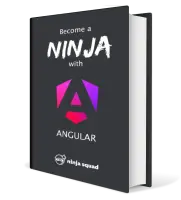Our Angular book, under the cover
Writing a technical book is a long, painful and difficult experience. I only took a small part in the writing of our two Angular books, Cédric being the main author, but even then, I know how hard it is.
It would be even harder if we had not chosen the good tools and processes to write it. And even more importantly, for you beloved readers (or future readers, hopefully), the book wouldn't have such a good quality.
This post will give you an overview of the tools and processes we use. You'll see that writing a book is very similar to writing software.
Team work
First of all, even if Cédric is, by large, the main developer of this book (I told you: a book is a software project), the book is actually the result of team work. The other ninjas, and even some friends external to Ninja Squad, helped translating and proof-reading the book. Or rather, the many iterations of the book.
You might think the book is written from the beginning to the end, chapter by chapter. That's not how it works. The structure has changed several times. Some chapters have been rewritten almost completely, several times. Sometimes because we were not satisfied, sometimes because Angular itself made big changes to their architecture and APIs (the forms, router and testing modules come to mind).
It would have been a nightmare to achieve that with a giant shared Word document. So the main tools we used were a text editor, Github, Asciidoctor, and shell scripts.
Each chapter (in French and English), has its own asciidoc file in the project, which is hosted in a Github repo.
Each time someone makes a change, he/she creates a branch and a pull request, and the change is proof-read, commented and amended until we're satisfied.
Using Asciidoctor makes that very easy: the document is pure readable text, which makes it simple to diff, comment and merge. Using the Asciidoctor toolchain, the asciidoc files are merged into a big document, and the HTML, PDF, epub and mobi versions of the book are generated.
Even the diagrams are generated from ascii-art, using asciidoctor-diagram. That makes it easy to produce and translate them.
We also use the comments from our Git commits, and a custom Java program, to generate a changelog.
Embedded code
Proof-reading the text is a human task. To proof-read the code snippets, however, we need more than that:
- errors in the code are more difficult to spot;
- we started working on the book when Angular was still in alpha, so each and every release introduced breaking changes in the code;
- readers are forgiving when it comes to typos (and several ones were kind enough to provide feedback about them), but they would be frustrated if the provided code snippets were incorrect.
So what's the solution here? Just as in any other software project: compilation, linting, and automated tests.
How can we compile and run automated tests for code snippets embedded in a document? Well, we can't. So that's not how we're doing it.
Asciidoctor allows including sections of external files into an asciidoc document. Here's how it looks like to extract a section of
an external typescript.spec.ts in the asciidoc document:
:specs: ../tests/specs/typescript/typescript.spec.ts
[...]
[source, javascript, indent=0]
----
include::{specs}[tags=variable-with-types]
----And here's how it looks like in the typescript.spec.ts:
[...]
it('should introduce types', () => {
// tag::variable-with-types[]
let poneyNumber: number = 0;
let poneyName: string = 'Rainbow Dash';
// end::variable-with-types[]
// asserts
expect(poneyNumber).toBe(0);
expect(poneyName).toBe('Rainbow Dash');
});
[...]Many tests are much more complex than this one, obviously, but Angular is very much testable, including the HTML templates, so it really allows testing each and every code snippet in the book. Our big test suite even allowed finding and reporting bugs in Angular itself sometimes.
The pro pack
The pro pack is another similar story. We of course want to be able to evolve the exercises from one Angular version to the next, and to make sure our provided solution is correct. If you have tested our pro pack already (the first 6 exercises are free, in case you want to), you know that each exercise comes with
- the project as it should be to start the exercise;
- unit and end-to-end tests to check that your solution is correct;
- tooling to check that all the code is covered by tests, and passes lint checks;
- the solution of the exercise.
Once again, automation and tests are key things to make that correct and maintainable. So Cédric has created a build process using custom scripts. The process automatically executes all the checks for each exercise of the pro pack one by one, using the files of the provided solution. A bit as if a robot passed through all the exercises and wrote the solution.
The demo application, is simply the result of the final exercise of the pro pack, amended with some branding and additional goodies by a final step of this whole build process.
Regarding the backend API of ponyracer, it's a Spring Boot application, written in Kotlin, and documented, once again using Asciidoctor and a set of automated tests using Spring REST Docs.
The training material
Of course, our training slides follow the same philosophy. Nothing is more frustrating than having a wrong snippet of code in your slides when you give a training. So we use an asciidoc file per training module to write our slides, thanks to asciidoctor-bespoke. This awesome project lets you write your slides in plain asciidoc and generates an HTML presentation (with Bespoke.js). A slide is really easy to write:
== Angular
[%build]
* announced in March 2014
* RC in May 2016
* stable in September 2016As it is a pure HTML presentation, you can customize the CSS, and insert dynamic Angular demos right into it. Of course, all code samples are in external files and are unit-tested just as for the ebook.
So what?
This wasn't meant to convince you to write a book by yourself. But even if you don't, many of the tools and processes described in this post can be used in other contexts.
The next time your pointy haired boss asks you to write a big Word document to describe your architecture or your library, you might want to convince him that much better collaborative tools are available to software engineers.
← Older post
What's new in Angular 2.1?
Newer post →
What's new in Angular 2.2?
Our books on sale


Next training sessions
- From Jan 12 to Jan 15, 2026Angular: Zero to Ninja(remote)
- From Jan 19 to Jan 22, 2026Angular: Ninja to Hero(remote)
- From Feb 9 to Feb 12, 2026Vue: Zero to Ninja(remote)
- From Mar 2 to Mar 5, 2026Angular: Zero to Ninja(remote)
